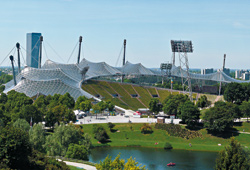A Second Look: The Olympic Ensemble in Munich - Consummate Work of Architecture or Ongoing Development?

Architectural historians count the Olympic Park in the north of Munich as one of the most important constructions of the 20th century as well as the best-maintained Olympic construction worldwide. This is not just down to the originality of the design, but, more importantly, due to the fact that after the 1972 Olympics and 1974 football World Cup, the Olympic Park has continued to be well used, with its open spaces becoming very much part of regular local life. The passing of time has left its mark, though; a variety of different buildings and constructions have gathered like dust over the years around the Olympic Stadium, the Olympic Hall and the Olympic Swim Hall. Administrative buildings now form a ring at the northern end of the Olympic Hall, while small porters’ gatehouses and snack stands have popped up around the park. The tent-style roofing and the swim hall have now all been renovated, while renovation work by Auer+Weber+Assozierte started on the Olympic Hall in 2007. The hall remains in use, but its logistics and stage technology are being brought right up to date. A restaurant with special VIP area that protrudes onto the neighbouring Coubertinplatz will open soon and the new Small Olympic Hall is set to be completed in 2011. The Olympic Park now finds itself at the necessary end of a phase of half-hearted renovation and expansion. What it really needs is a ‘master plan’ to drag the whole area into the next generation as a lively event and leisure location, independent of an option to host the Winter Olympics in 2018. One thing is for sure, though: the park will always be a monument with a deep-lying history.
